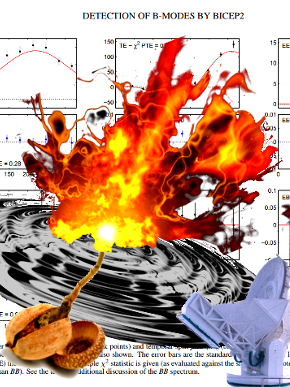Universal echoes bring Big Bang physics into a new age
 Physicists have discovered evidence from the first few billionths of a second after the universe formed.
Physicists have discovered evidence from the first few billionths of a second after the universe formed.
The importance of the discovery is difficult to overstate; it sheds light on the very first moments of our universe, the Big Bang, Dark Energy, quantum physics and the origin of matter itself.
A team at the Harvard-Smithsonian Center for Astrophysics announced on Monday that it had found the first direct evidence for the existence of an ‘Inflation Field’ in the formation of the universe.
The discovery was made within data from measurements of the Cosmic Microwave Background (CMB); radiation that is already known to have emerged in the very early days of the universe.
CMB was formed when the universe was already about 378,000 years old, but the new evidence helps explain what happened between 10-36 and 10-32 seconds after the Big Bang – the spark that triggered events we still experience 14 billion years later.
The Cosmic Microwave Background is often described as the echo of the Big Bang, but between the Bang and CMB there was an ‘Inflation Epoch’, which guided the initial shape of the universe. The existence of this inflation is what has now been proven, in the form of polarised waves within background microwaves.
During the tiny sliver of a second that the Big Bang and Inflationary Epoch took, the universe increased in volume by a factor of 1078 - taking shape and expanding at a rate faster than the speed of light. The rapid inflation eventually ran out of energy, leaving CMB and the traditional laws of physics in its wake.
The proof of the Inflation Field came from analysis of the shape of the CMB, which is surprisingly round. The deviations in the surface of the field and the patterns of key polarisation are massively amplified representations of this brief yet highly-charged Inflationary Epoch.
Not only was the evidence of inflation found in the microwaves, it was considerably more clear than expected.
“This has been like looking for a needle in a haystack, but instead we found a crowbar,” researcher Clem Pryke said.
The Inflation Field is hypothesised to have provided energy to virtual particles when the universe began, giving them mass for the first time and generating the basic matter that now comprises our universe – the contents of everything from the Sun to Spandau Ballet was formed in the incredible epoch of expansion.
“Detecting this signal is one of the most important goals in cosmology today,” John Kovac, leader of the research at the Harvard-Smithsonian Center, said.
“A lot of work by a lot of people has led up to this point.”
Harvard theorist Avi Loeb says “this work offers new insights into some of our most basic questions: Why do we exist? How did the universe begin? These results are not only a smoking gun for inflation, they also tell us when inflation took place and how powerful the process was.”
The discovery marks a new era in the search for a unified theory of everything - confirming the last untested element of Albert Einstein's general theory of relativity and showing that it is intrinsically linked with quantum mechanics.
The discovery was made using the radio telescope BICEP2 (Background Imaging of Cosmic Extragalactic Polarization).
Technical details and journal papers can be found on the BICEP2 release website.
A video of the technical presentation of the data is accessible here.
The following video shows one member of the research team informing the man who first conceived the Big Bang Inflation theory, Professor Andrei Linde, of the discovery proving his hypothesis after thirty years.







 Print
Print